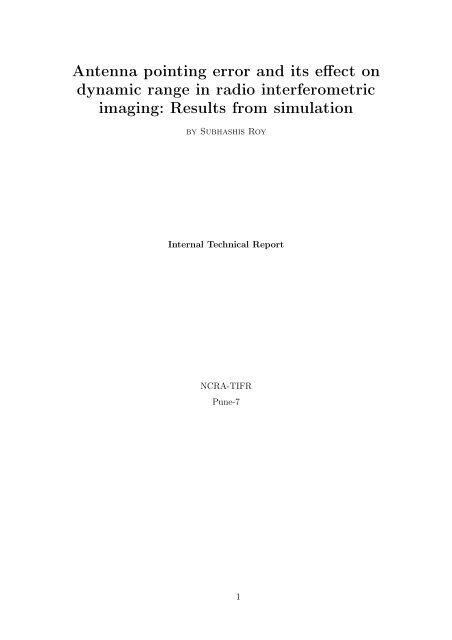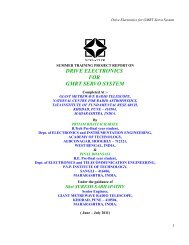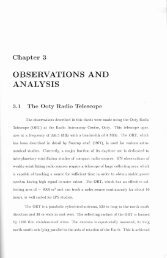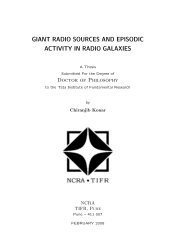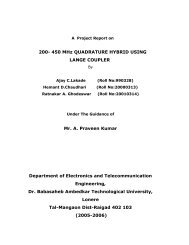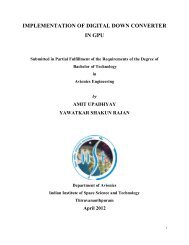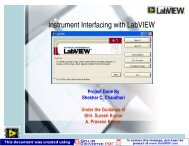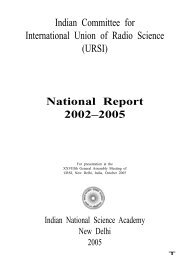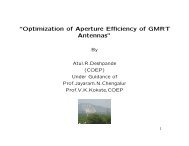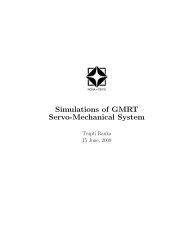Antenna pointing error and its effect on dynamic range in radio ...
Antenna pointing error and its effect on dynamic range in radio ...
Antenna pointing error and its effect on dynamic range in radio ...
You also want an ePaper? Increase the reach of your titles
YUMPU automatically turns print PDFs into web optimized ePapers that Google loves.
<str<strong>on</strong>g>Antenna</str<strong>on</strong>g> <str<strong>on</strong>g>po<strong>in</strong>t<strong>in</strong>g</str<strong>on</strong>g> <str<strong>on</strong>g>error</str<strong>on</strong>g> <str<strong>on</strong>g>and</str<strong>on</strong>g> <str<strong>on</strong>g>its</str<strong>on</strong>g> <str<strong>on</strong>g>effect</str<strong>on</strong>g> <strong>on</strong><br />
<strong>dynamic</strong> <strong>range</strong> <strong>in</strong> <strong>radio</strong> <strong>in</strong>terferometric<br />
imag<strong>in</strong>g: Results from simulati<strong>on</strong><br />
by Subhashis Roy<br />
Internal Technical Report<br />
NCRA-TIFR<br />
Pune-7<br />
1
2 Secti<strong>on</strong><br />
Table of c<strong>on</strong>tents<br />
1 Introducti<strong>on</strong>: . . . . . . . . . . . . . . . . . . . . . . . . . . . . . . . . . . . . . . 3<br />
2 Analytical models of Po<strong>in</strong>t<strong>in</strong>g <str<strong>on</strong>g>error</str<strong>on</strong>g>s: . . . . . . . . . . . . . . . . . . . . . 4<br />
2.1 S<strong>in</strong>gle source with a s<strong>in</strong>gle dish . . . . . . . . . . . . . . . . . . . . . . . . . 4<br />
2.2 C<strong>on</strong>tributi<strong>on</strong> of <str<strong>on</strong>g>po<strong>in</strong>t<strong>in</strong>g</str<strong>on</strong>g> <str<strong>on</strong>g>error</str<strong>on</strong>g> <strong>in</strong> limit<strong>in</strong>g <strong>dynamic</strong> <strong>range</strong>s of <strong>in</strong>terferometric<br />
maps: . . . . . . . . . . . . . . . . . . . . . . . . . . . . . . . . . . . . . . . . . . . . 7<br />
Order of magnitude estimati<strong>on</strong> of <strong>dynamic</strong> <strong>range</strong> . . . . . . . . . . . . . . 7<br />
2.3 Multiple sources: . . . . . . . . . . . . . . . . . . . . . . . . . . . . . . . . . . 9<br />
3 Simulati<strong>on</strong> of Po<strong>in</strong>t<strong>in</strong>g <str<strong>on</strong>g>error</str<strong>on</strong>g>: . . . . . . . . . . . . . . . . . . . . . . . . . . 10<br />
3.1 Systematic <str<strong>on</strong>g>error</str<strong>on</strong>g> <strong>in</strong> visibility amplitude due to a fixed azimuth or elevati<strong>on</strong><br />
<str<strong>on</strong>g>error</str<strong>on</strong>g> <strong>in</strong> an antenna . . . . . . . . . . . . . . . . . . . . . . . . . . . . . . . . . . 11<br />
3.2 Systematic <str<strong>on</strong>g>error</str<strong>on</strong>g> <strong>on</strong> map from a fixed elevati<strong>on</strong> <str<strong>on</strong>g>error</str<strong>on</strong>g>: . . . . . . . . . . 12<br />
3.3 Dependence of <strong>dynamic</strong> <strong>range</strong> with sidelobes of synthesised beam . . 15<br />
3.4 Dynamic <strong>range</strong> limitati<strong>on</strong> while observ<strong>in</strong>g typical extragalactic fields due to<br />
<str<strong>on</strong>g>po<strong>in</strong>t<strong>in</strong>g</str<strong>on</strong>g> <str<strong>on</strong>g>error</str<strong>on</strong>g> . . . . . . . . . . . . . . . . . . . . . . . . . . . . . . . . . . . . . . 16<br />
3.4.1 Static <str<strong>on</strong>g>and</str<strong>on</strong>g> <strong>dynamic</strong> <str<strong>on</strong>g>po<strong>in</strong>t<strong>in</strong>g</str<strong>on</strong>g> <str<strong>on</strong>g>error</str<strong>on</strong>g> . . . . . . . . . . . . . . . . . . . 16<br />
3.4.2 Simulat<strong>in</strong>g the logN–logS distributi<strong>on</strong> of sources <strong>in</strong> field of view: 17<br />
3.4.3 Results . . . . . . . . . . . . . . . . . . . . . . . . . . . . . . . . . . . . 18<br />
4 Implicati<strong>on</strong>s <str<strong>on</strong>g>and</str<strong>on</strong>g> possible soluti<strong>on</strong>s: . . . . . . . . . . . . . . . . . . . . . 20<br />
Acknowledgement . . . . . . . . . . . . . . . . . . . . . . . . . . . . . . . . . . . . 20
<str<strong>on</strong>g>Antenna</str<strong>on</strong>g> <str<strong>on</strong>g>po<strong>in</strong>t<strong>in</strong>g</str<strong>on</strong>g> <str<strong>on</strong>g>error</str<strong>on</strong>g> <str<strong>on</strong>g>and</str<strong>on</strong>g> <str<strong>on</strong>g>its</str<strong>on</strong>g> <str<strong>on</strong>g>effect</str<strong>on</strong>g> <strong>on</strong><br />
<strong>dynamic</strong> <strong>range</strong> <strong>in</strong> <strong>radio</strong> <strong>in</strong>terferometric<br />
imag<strong>in</strong>g: Results from Simulati<strong>on</strong><br />
Abstract<br />
<str<strong>on</strong>g>Antenna</str<strong>on</strong>g> <str<strong>on</strong>g>po<strong>in</strong>t<strong>in</strong>g</str<strong>on</strong>g> <str<strong>on</strong>g>error</str<strong>on</strong>g>s could play a significant role <strong>in</strong> limit<strong>in</strong>g the <strong>dynamic</strong><br />
<strong>range</strong>s achievable with present day <strong>radio</strong> <strong>in</strong>terferometers. I have carried out<br />
a detailed analysis of this limitati<strong>on</strong> us<strong>in</strong>g both analytical <str<strong>on</strong>g>and</str<strong>on</strong>g> simulati<strong>on</strong><br />
methods with particular emphasis <strong>on</strong> c<strong>on</strong>t<strong>in</strong>uum imag<strong>in</strong>g with GMRT data<br />
at metre wavelengths. It is found that limitati<strong>on</strong> of <strong>dynamic</strong> <strong>range</strong> not <strong>on</strong>ly<br />
depends <strong>on</strong> the magnitude of <str<strong>on</strong>g>po<strong>in</strong>t<strong>in</strong>g</str<strong>on</strong>g> <str<strong>on</strong>g>error</str<strong>on</strong>g>s, but also <strong>on</strong> the sidelobe pattern<br />
of the synthesised beam. Us<strong>in</strong>g typical <str<strong>on</strong>g>po<strong>in</strong>t<strong>in</strong>g</str<strong>on</strong>g> <str<strong>on</strong>g>error</str<strong>on</strong>g> of ∼1 ′ at 90 cm<br />
with GMRT, the typical rms <str<strong>on</strong>g>error</str<strong>on</strong>g> that is reached while observ<strong>in</strong>g a typical<br />
extragalactic field is∼50 µJy, that is about three times higher than the thermal<br />
sensitivity of GMRT (32 MHz b<str<strong>on</strong>g>and</str<strong>on</strong>g>width) with full synthesis. In real life,<br />
this could worsen by another factor of a few due to <str<strong>on</strong>g>po<strong>in</strong>t<strong>in</strong>g</str<strong>on</strong>g>s d<strong>on</strong>e at each of the<br />
observ<strong>in</strong>g b<str<strong>on</strong>g>and</str<strong>on</strong>g>s <strong>in</strong>clud<strong>in</strong>g the <strong>on</strong>es at lower frequencies (e.g., 330 <str<strong>on</strong>g>and</str<strong>on</strong>g> 150 MHz)<br />
lead<strong>in</strong>g to poorer <str<strong>on</strong>g>po<strong>in</strong>t<strong>in</strong>g</str<strong>on</strong>g> accuracies at these frequency b<str<strong>on</strong>g>and</str<strong>on</strong>g>s than is possible<br />
at the highest frequency (L) b<str<strong>on</strong>g>and</str<strong>on</strong>g>. This can be improved with a better feed<br />
positi<strong>on</strong><strong>in</strong>g system, al<strong>on</strong>g with better track<strong>in</strong>g accuracy of the servo system.<br />
1 Introducti<strong>on</strong>:<br />
There exists a Fourier transform (FT) relati<strong>on</strong>ship that relates the Visibility [V (u,<br />
v)] obta<strong>in</strong>ed after cross-correlat<strong>in</strong>g <str<strong>on</strong>g>and</str<strong>on</strong>g> calibrat<strong>in</strong>g the voltages as measured at different<br />
antenna locati<strong>on</strong>s with the sky <strong>in</strong>tensity distributi<strong>on</strong>I(l,m). This relati<strong>on</strong>ship<br />
is known as Van-Cittert Zernecki theorem, <str<strong>on</strong>g>and</str<strong>on</strong>g> serves as the basis for imag<strong>in</strong>g <strong>in</strong><br />
<strong>radio</strong> <strong>in</strong>terferometry. It can be expressed as:<br />
∫ ∫<br />
V(u,v)= I(l,m)exp[−2πi(ul+vm)]dl.dm (1)<br />
In the above expressi<strong>on</strong>, I(l,m) is the observed sky <strong>in</strong>tensity distributi<strong>on</strong>. Note that<br />
the observed sky <strong>in</strong>tensity is a product of the true sky <strong>in</strong>tensity distributi<strong>on</strong> [I true (l,<br />
m)] <str<strong>on</strong>g>and</str<strong>on</strong>g> the primary beam pattern of the antennas [A(l,m)]. For Eq. 1 to rema<strong>in</strong><br />
c<strong>on</strong>sistent for visibilities acquired through different pair of antennas,I(l,m) must be<br />
the same for all the antennas. This requires two c<strong>on</strong>diti<strong>on</strong>s, (i) The primary beam<br />
pattern (A) must be same for all antennas, <str<strong>on</strong>g>and</str<strong>on</strong>g> (ii) all the antennas must be <str<strong>on</strong>g>po<strong>in</strong>t<strong>in</strong>g</str<strong>on</strong>g><br />
to the same directi<strong>on</strong> of the sky so that their directi<strong>on</strong> cos<strong>in</strong>es (l,m) is the same.<br />
3
4 Secti<strong>on</strong> 2<br />
For typical antennas used <strong>in</strong> work<strong>in</strong>g <strong>in</strong>terferometers at cm to metre wavelengths<br />
(e.g., WSRT, VLA or GMRT), all the antennas <strong>in</strong> a particular array are made<br />
follow<strong>in</strong>g the same design, <str<strong>on</strong>g>and</str<strong>on</strong>g> hence the primary beam pattern is expected to be<br />
the same for all the antennas. However, due to mechanical limitati<strong>on</strong>s, if different<br />
antennas po<strong>in</strong>t at slightly different directi<strong>on</strong>s,A(l,m) need to be written asA(l i ,m i ),<br />
where i is the antenna number, <str<strong>on</strong>g>and</str<strong>on</strong>g> <strong>in</strong> general will differ am<strong>on</strong>g antennas. This<br />
causes <str<strong>on</strong>g>po<strong>in</strong>t<strong>in</strong>g</str<strong>on</strong>g> <str<strong>on</strong>g>error</str<strong>on</strong>g> <str<strong>on</strong>g>and</str<strong>on</strong>g> different antennas “see” different flux-densities of sources<br />
as a functi<strong>on</strong> of angular distance from the actual <str<strong>on</strong>g>po<strong>in</strong>t<strong>in</strong>g</str<strong>on</strong>g> centre of each antennas.<br />
A <str<strong>on</strong>g>po<strong>in</strong>t<strong>in</strong>g</str<strong>on</strong>g> <str<strong>on</strong>g>error</str<strong>on</strong>g> of 5% of the antenna primary beam width causes flux density of<br />
sources seen near FWHM to change by ∼15%. This <str<strong>on</strong>g>po<strong>in</strong>t<strong>in</strong>g</str<strong>on</strong>g> accuracy has typically<br />
been c<strong>on</strong>sidered as acceptable at the highest frequency of operati<strong>on</strong> <strong>in</strong> exist<strong>in</strong>g<br />
<strong>in</strong>terferometers (Synthesis imag<strong>in</strong>g <strong>in</strong> Radio Astr<strong>on</strong>omy, ASP C<strong>on</strong>f. Ser., 180, chap.<br />
3, p51) built more than a decade back. Presence of ∼15% <str<strong>on</strong>g>error</str<strong>on</strong>g> <strong>in</strong> source flux<br />
densities at FWHM <strong>in</strong> the highest observ<strong>in</strong>g b<str<strong>on</strong>g>and</str<strong>on</strong>g> that progressively gets small<br />
at l<strong>on</strong>ger wavelengths may not be a serious problem, but failure of Equati<strong>on</strong> (1)<br />
causes artefacts dur<strong>in</strong>g dec<strong>on</strong>voluti<strong>on</strong> us<strong>in</strong>g that equati<strong>on</strong>, <str<strong>on</strong>g>and</str<strong>on</strong>g> reduces the <strong>dynamic</strong><br />
<strong>range</strong> of maps from <strong>radio</strong> <strong>in</strong>terferometric data. At higher <strong>radio</strong> frequencies (>1.4<br />
GHz), the primary beam of typical parabolic antenna based <strong>in</strong>terferometers are quite<br />
small (30 ′ , for GMRT, VLA <str<strong>on</strong>g>and</str<strong>on</strong>g> WSRT), <str<strong>on</strong>g>and</str<strong>on</strong>g> often the target source is at the<br />
centre of the beam. C<strong>on</strong>sequently, the <str<strong>on</strong>g>effect</str<strong>on</strong>g> of <str<strong>on</strong>g>po<strong>in</strong>t<strong>in</strong>g</str<strong>on</strong>g> <str<strong>on</strong>g>error</str<strong>on</strong>g>s is less important at<br />
higher frequencies. However, with emphasis <strong>on</strong> high <strong>dynamic</strong> <strong>range</strong> low frequency<br />
observati<strong>on</strong>s with the exist<strong>in</strong>g facilities like the GMRT <str<strong>on</strong>g>and</str<strong>on</strong>g> other upcom<strong>in</strong>g facilities<br />
like ASKAP, it has become important to quantify the <str<strong>on</strong>g>effect</str<strong>on</strong>g> of <str<strong>on</strong>g>po<strong>in</strong>t<strong>in</strong>g</str<strong>on</strong>g> <str<strong>on</strong>g>error</str<strong>on</strong>g> <strong>on</strong><br />
image <strong>dynamic</strong> <strong>range</strong>, <str<strong>on</strong>g>and</str<strong>on</strong>g> this report is expected to address that. Analys<strong>in</strong>g <str<strong>on</strong>g>its</str<strong>on</strong>g><br />
<str<strong>on</strong>g>effect</str<strong>on</strong>g> <strong>in</strong> the map plane is complex. I would analyse it from simple analytical <str<strong>on</strong>g>and</str<strong>on</strong>g><br />
simulati<strong>on</strong> models.<br />
2 Analytical models of Po<strong>in</strong>t<strong>in</strong>g <str<strong>on</strong>g>error</str<strong>on</strong>g>s:<br />
2.1 S<strong>in</strong>gle source with a s<strong>in</strong>gle dish<br />
To make a best fit to a parabolic antenna primary beam pattern with<strong>in</strong> the ma<strong>in</strong><br />
lobe, often a polynomial is used. However, as shown <strong>in</strong> Fig. 1, it is pretty close to a<br />
Gaussian for GMRT antennas. Therefore, to keep the analysis simple, we c<strong>on</strong>sider<br />
a Gaussian Primary beam pattern.
Analytical models of Po<strong>in</strong>t<strong>in</strong>g <str<strong>on</strong>g>error</str<strong>on</strong>g>s: 5<br />
Figure 1. Plot of GMRT antenna resp<strong>on</strong>se at 330 MHz approximated with the st<str<strong>on</strong>g>and</str<strong>on</strong>g>ard<br />
Polynomial fit used for primary beam correcti<strong>on</strong> (Green) versus a Gaussian (Red).<br />
Then, we can express flux density (S) of a source seen at an angle θ from the<br />
axis as<br />
( )<br />
S(θ)=S 0 .exp − θ2<br />
, (2)<br />
2.σ 2<br />
where, S 0 is the true flux density of the source, <str<strong>on</strong>g>and</str<strong>on</strong>g> σ is related to the FWHM of<br />
the Gaussian functi<strong>on</strong> by σ = 0.42×FWHM. In this report, we denote σ as half<br />
beam width.<br />
Change <strong>in</strong> normalised flux density of a source due to small change <strong>in</strong> θ (∆θ) is<br />
obta<strong>in</strong>ed by differentiat<strong>in</strong>g the above:<br />
( ) ( )<br />
1 θ<br />
∆S(θ)=− exp − θ2<br />
.∆θ<br />
S 0 σ 2 2.σ 2<br />
From above, we f<strong>in</strong>d that <str<strong>on</strong>g>error</str<strong>on</strong>g> <strong>in</strong> flux density (∆S) for a fixed <str<strong>on</strong>g>po<strong>in</strong>t<strong>in</strong>g</str<strong>on</strong>g> <str<strong>on</strong>g>error</str<strong>on</strong>g> ∆θ<br />
depends <strong>on</strong> the relative angular offset (θ) of the source with respect to the beamwidth<br />
(∼2σ). Peak occurs at θ = σ. As beam width is <strong>in</strong>versely proporti<strong>on</strong>al to
6 Secti<strong>on</strong> 2<br />
frequency, we substitute σ∝ σ 1<br />
. As ∆S depends <strong>on</strong> the relative angular offset of the<br />
ν<br />
source with respect to the beam width, we def<strong>in</strong>e θ =Θ. Where, σ σ 1 corresp<strong>on</strong>ds to<br />
beam-width at 1 GHz, <str<strong>on</strong>g>and</str<strong>on</strong>g> Θ denotes angular offset normalised by the beam-width.<br />
∆S=S 0 .ν. Θ ( )<br />
.exp − Θ2<br />
.∆θ (3)<br />
σ 1 2<br />
0.7<br />
0.6<br />
Error <strong>in</strong> flux density due to static <str<strong>on</strong>g>po<strong>in</strong>t<strong>in</strong>g</str<strong>on</strong>g> <str<strong>on</strong>g>error</str<strong>on</strong>g> (arbitrary unit)<br />
0.5<br />
0.4<br />
0.3<br />
0.2<br />
0.1<br />
0<br />
0 0.5 1 1.5 2 2.5<br />
Source angular offset <strong>in</strong> un<str<strong>on</strong>g>its</str<strong>on</strong>g> of σ<br />
Figure 2. Flux density <str<strong>on</strong>g>error</str<strong>on</strong>g> due to mis-<str<strong>on</strong>g>po<strong>in</strong>t<strong>in</strong>g</str<strong>on</strong>g> (ν=1).<br />
From (2), we f<strong>in</strong>d that flux-<str<strong>on</strong>g>error</str<strong>on</strong>g> (∆S) for the same angular offset is proporti<strong>on</strong>al<br />
to frequency. A plot of Eq. (2) assum<strong>in</strong>g ν is unity is shown <strong>in</strong> Figure 2. From<br />
Fig. 2, we f<strong>in</strong>d that the <str<strong>on</strong>g>po<strong>in</strong>t<strong>in</strong>g</str<strong>on</strong>g> <str<strong>on</strong>g>error</str<strong>on</strong>g> rema<strong>in</strong>s above half <str<strong>on</strong>g>its</str<strong>on</strong>g> maximum value for<br />
0.3
Analytical models of Po<strong>in</strong>t<strong>in</strong>g <str<strong>on</strong>g>error</str<strong>on</strong>g>s: 7<br />
2.2 C<strong>on</strong>tributi<strong>on</strong> of <str<strong>on</strong>g>po<strong>in</strong>t<strong>in</strong>g</str<strong>on</strong>g> <str<strong>on</strong>g>error</str<strong>on</strong>g> <strong>in</strong> limit<strong>in</strong>g <strong>dynamic</strong> <strong>range</strong>s<br />
of <strong>in</strong>terferometric maps:<br />
From <strong>in</strong>verse of Eq. (1), <strong>on</strong>e can write source <strong>in</strong>tensity as <strong>in</strong> a Dirty map (I D ) <strong>in</strong><br />
terms of a Fourier series.<br />
I D = 1 ∑M<br />
V(u k ,v k ).e 2πi(u kl+v k m)<br />
(4)<br />
M<br />
k=1<br />
where, u k ,v k are the po<strong>in</strong>ts <strong>in</strong> the u,v plane where visibility measurements exists,<br />
<str<strong>on</strong>g>and</str<strong>on</strong>g> M is the total number of visibilities (M ∝N(N −1)/2, where N is the no. of<br />
antennas <strong>in</strong> the array). By def<strong>in</strong><strong>in</strong>g the sampl<strong>in</strong>g functi<strong>on</strong>, S = ∑M δ(u − u<br />
k=1 k ,<br />
v−v k ), it can be shown that I=B∗FT(V), where B is the FT of S.<br />
Order of magnitude estimati<strong>on</strong> of <strong>dynamic</strong> <strong>range</strong><br />
I first c<strong>on</strong>sider <str<strong>on</strong>g>po<strong>in</strong>t<strong>in</strong>g</str<strong>on</strong>g> <str<strong>on</strong>g>error</str<strong>on</strong>g> for <strong>on</strong>e of the antennas (n) that results <strong>in</strong> flux density<br />
<str<strong>on</strong>g>error</str<strong>on</strong>g> of ∼∆S for a s<strong>in</strong>gle po<strong>in</strong>t source <strong>in</strong> the primary beam of the antenna. The flux<br />
density as measured <strong>in</strong> total power for antenna ‘n’ is S(1+∆G). Where, ∆G= ∆S , S<br />
<str<strong>on</strong>g>and</str<strong>on</strong>g> results <strong>in</strong> an <str<strong>on</strong>g>error</str<strong>on</strong>g> of ∆G <strong>in</strong> the voltage ga<strong>in</strong> of that antenna. S<strong>in</strong>ce the <str<strong>on</strong>g>error</str<strong>on</strong>g><br />
2<br />
under c<strong>on</strong>siderati<strong>on</strong> occurs <strong>in</strong> amplitude, it would appear as an amplitude ga<strong>in</strong><br />
<str<strong>on</strong>g>error</str<strong>on</strong>g>, that is symmetric around a source. One can do a phase shift<strong>in</strong>g of the source<br />
visibilities so as to image it at the phase centre. In this case, assum<strong>in</strong>g no noise or<br />
other artefacts <strong>in</strong> the data, the resultant Dirty image can be expressed as:<br />
⎛<br />
I D (l,m)= 1 ⎝ ∑ M<br />
N−1<br />
V I (u k ,v k ).e 2πi(u kl+v k m) + ∑<br />
M<br />
k=1<br />
i=1,ni<br />
⎞<br />
∆S<br />
2 (u <strong>in</strong>,v <strong>in</strong> ).e 2πi(u <strong>in</strong>l+v <strong>in</strong> m) ⎠ (5)<br />
In the above, we have c<strong>on</strong>sidered <strong>on</strong>ly <strong>on</strong>e time-stamp, so that M=N(N −1)/2.<br />
One can f<strong>in</strong>d the first part is the st<str<strong>on</strong>g>and</str<strong>on</strong>g>ard expressi<strong>on</strong> of a Dirty image. By subtract<strong>in</strong>g<br />
the synthesised beam pattern dur<strong>in</strong>g Clean dec<strong>on</strong>voluti<strong>on</strong>, the diffracti<strong>on</strong><br />
pattern for the source from the map will be removed. However, the sec<strong>on</strong>d term<br />
<strong>in</strong>dicates the Dirty image formed by us<strong>in</strong>g data hav<strong>in</strong>g err<strong>on</strong>eous flux density ( ∆S)<br />
2<br />
as c<strong>on</strong>ta<strong>in</strong>ed <strong>in</strong> all the visibilities with that antenna.
8 Secti<strong>on</strong> 2<br />
S<strong>in</strong>ce the no. of visibilities that is c<strong>on</strong>tributed by <strong>on</strong>e antenna <strong>in</strong> an array with<br />
N elements at any <strong>in</strong>stant is (N −1), the <str<strong>on</strong>g>error</str<strong>on</strong>g> <strong>in</strong> the dirty map at the positi<strong>on</strong> of<br />
∆S.(N −1) N.(N −1)<br />
the source will be ∼ ÷ = ∆S . Assum<strong>in</strong>g N ≫1 (as <strong>in</strong> any modern<br />
2 2 N<br />
<strong>radio</strong> <strong>in</strong>terferometers), <str<strong>on</strong>g>error</str<strong>on</strong>g> <strong>in</strong> flux density at the positi<strong>on</strong> of the source is much<br />
less than what is seen by the particular antenna with <str<strong>on</strong>g>po<strong>in</strong>t<strong>in</strong>g</str<strong>on</strong>g> <str<strong>on</strong>g>error</str<strong>on</strong>g>. Therefore, we<br />
can c<strong>on</strong>sider the flux density of the Clean comp<strong>on</strong>ent at the positi<strong>on</strong> of the source<br />
that is picked up by CLEAN dur<strong>in</strong>g dec<strong>on</strong>voluti<strong>on</strong> is the right flux density for the<br />
source. Clean then subtracts the diffracti<strong>on</strong> pattern of the source comp<strong>on</strong>ents with<br />
the right flux density. This would take away the diffracti<strong>on</strong> pattern for all basel<strong>in</strong>es<br />
except the <strong>on</strong>es formed by <strong>in</strong>clud<strong>in</strong>g the antenna hav<strong>in</strong>g <str<strong>on</strong>g>po<strong>in</strong>t<strong>in</strong>g</str<strong>on</strong>g> <str<strong>on</strong>g>error</str<strong>on</strong>g>. If we def<strong>in</strong>e<br />
the beam of the sampl<strong>in</strong>g functi<strong>on</strong> that is formed with all the basel<strong>in</strong>es with that<br />
antenna as B n , then the <str<strong>on</strong>g>error</str<strong>on</strong>g> pattern left <strong>on</strong> the map as <strong>in</strong> sec<strong>on</strong>d part of Eq. (5) is<br />
∼ ∆S.B n(p,q)<br />
, (6)<br />
N<br />
where N <strong>in</strong> the denom<strong>in</strong>ator appear due to normalisati<strong>on</strong> as denoted by ‘M’ <strong>in</strong><br />
Eq. (4). It has to be noted that the beam pattern except at <str<strong>on</strong>g>its</str<strong>on</strong>g> orig<strong>in</strong> is oscillatory<br />
go<strong>in</strong>g through positive <str<strong>on</strong>g>and</str<strong>on</strong>g> negative values. Dur<strong>in</strong>g imag<strong>in</strong>g, if data weights near the<br />
boundaries of UV plane where data exists are suitably tapered to avoid r<strong>in</strong>g<strong>in</strong>g due<br />
to sudden cutoff <strong>in</strong> data, <str<strong>on</strong>g>and</str<strong>on</strong>g> if the antennas are placed such that the UV coverage<br />
generated by different basel<strong>in</strong>es are close to be<strong>in</strong>g r<str<strong>on</strong>g>and</str<strong>on</strong>g>om <strong>in</strong> UV plane, the side<br />
lobes from beams as formed by different basel<strong>in</strong>es add r<str<strong>on</strong>g>and</str<strong>on</strong>g>omly <strong>in</strong> the map plane.<br />
Therefore, sidelobe amplitudes <strong>in</strong> dirty beam is almost <strong>in</strong>versely proporti<strong>on</strong>al to the<br />
square root of the number of basel<strong>in</strong>es <strong>in</strong>volved <strong>in</strong> form<strong>in</strong>g the beam. Therefore, we<br />
can write<br />
√<br />
B n (p,q)∼ N .B(p,q) (7)<br />
2<br />
2N<br />
, where p,q (p,q are outside the ma<strong>in</strong> lobe of the synthesised beam) are the positi<strong>on</strong><br />
of any po<strong>in</strong>t <strong>in</strong> the map <strong>in</strong> pixels al<strong>on</strong>g East <str<strong>on</strong>g>and</str<strong>on</strong>g> North with the centre of the coord<strong>in</strong>ate<br />
be<strong>in</strong>g co<strong>in</strong>cident with the beam centre. Therefore, the <str<strong>on</strong>g>error</str<strong>on</strong>g> that is left <strong>in</strong><br />
the map plane <strong>in</strong> general can be obta<strong>in</strong>ed by replac<strong>in</strong>g B n <strong>in</strong> Eq. (6) by B from<br />
√<br />
Eq. 7 <str<strong>on</strong>g>and</str<strong>on</strong>g> is ∼ 1 .∆S.B(p−p ′ ,q−q ′ ). Where, p ′ <str<strong>on</strong>g>and</str<strong>on</strong>g> q ′ are the pixel based coord<strong>in</strong>ate<br />
of the source. Po<strong>in</strong>t<strong>in</strong>g <str<strong>on</strong>g>error</str<strong>on</strong>g>s be<strong>in</strong>g antenna based, when all the antennas<br />
suffer from <str<strong>on</strong>g>po<strong>in</strong>t<strong>in</strong>g</str<strong>on</strong>g> <str<strong>on</strong>g>error</str<strong>on</strong>g>s, <str<strong>on</strong>g>error</str<strong>on</strong>g>s from them will add r<str<strong>on</strong>g>and</str<strong>on</strong>g>omly <strong>in</strong> the map plane.<br />
If ∆S is the rms <str<strong>on</strong>g>error</str<strong>on</strong>g> <strong>in</strong> flux density by different antennas due to <str<strong>on</strong>g>po<strong>in</strong>t<strong>in</strong>g</str<strong>on</strong>g> <str<strong>on</strong>g>error</str<strong>on</strong>g> of<br />
a source, then at a positi<strong>on</strong> p−p ′ ,q−q ′ pixels away from the √ source, the map <str<strong>on</strong>g>error</str<strong>on</strong>g><br />
as computed for a s<strong>in</strong>gle antenna need to be multiplied by N . Then we get,<br />
Map rms∼√ 1 ∆S.B(p−p ′ ,q−q ′ ) (8)<br />
2
Analytical models of Po<strong>in</strong>t<strong>in</strong>g <str<strong>on</strong>g>error</str<strong>on</strong>g>s: 9<br />
2.3 Multiple sources:<br />
S<strong>in</strong>ce there are many sources <strong>in</strong> sky, it is important to estimate their overall c<strong>on</strong>tributi<strong>on</strong>.<br />
Str<strong>on</strong>g sources c<strong>on</strong>tributes mostly to the <str<strong>on</strong>g>po<strong>in</strong>t<strong>in</strong>g</str<strong>on</strong>g> <str<strong>on</strong>g>error</str<strong>on</strong>g> (e.g., Eq. 3). Typically<br />
GMRT can detect mJy sources at metre wavelengths. However, the sources with<br />
flux densities of hundreds of mJy or more c<strong>on</strong>tribute largely to the <str<strong>on</strong>g>po<strong>in</strong>t<strong>in</strong>g</str<strong>on</strong>g> <str<strong>on</strong>g>error</str<strong>on</strong>g>.<br />
These sources be<strong>in</strong>g>>5σ, they are seen almost up to twice the primary beam of the<br />
antennas. Therefore, their detecti<strong>on</strong> is not significantly dependent <strong>on</strong> the primary<br />
beam attenuati<strong>on</strong> at least up to the FWHM, that is close to the <str<strong>on</strong>g>effect</str<strong>on</strong>g>ive beam area.<br />
It is known that source number density (k) above a certa<strong>in</strong> <strong>range</strong> of flux densities<br />
(say >10σ) is proporti<strong>on</strong>al to the area of the sky be<strong>in</strong>g observed. Also, from Fig. 2,<br />
<str<strong>on</strong>g>po<strong>in</strong>t<strong>in</strong>g</str<strong>on</strong>g> <str<strong>on</strong>g>error</str<strong>on</strong>g> from sources <strong>in</strong> most parts of the primary beam is similar (with<strong>in</strong> a<br />
factor of two). Therefore, map rms would be proporti<strong>on</strong>al to the square root of the<br />
√<br />
no. of sources (K) present <strong>in</strong> the primary beam. One can write, rms ∝ K .∆S, <str<strong>on</strong>g>and</str<strong>on</strong>g><br />
as the primary beam area is <strong>in</strong>versely proporti<strong>on</strong>al to the square of the observ<strong>in</strong>g<br />
√<br />
frequency, K ∝ν −1 . After substitut<strong>in</strong>g the expressi<strong>on</strong> of ∆S from Eq. (3), we get<br />
rms ∝ν −1 .ν.S 0<br />
Θ<br />
σ 1<br />
.exp(−Θ 2 ).∆θ.<br />
In the above case, all the terms except S 0 are frequency <strong>in</strong>dependent. As S 0 ∝ν α ,<br />
whereαis the spectral <strong>in</strong>dex <str<strong>on</strong>g>and</str<strong>on</strong>g> is ∼−0.8 for typical extragalactic <strong>radio</strong> sources, we<br />
f<strong>in</strong>ally get map rms ∝ν −0.8 . This implies that images made at lower frequencies will<br />
be more affected by <str<strong>on</strong>g>po<strong>in</strong>t<strong>in</strong>g</str<strong>on</strong>g> <str<strong>on</strong>g>error</str<strong>on</strong>g>s of the antennas. For GMRT, the most sensitive<br />
lowest frequency b<str<strong>on</strong>g>and</str<strong>on</strong>g> is at 330 MHz. Therefore, <strong>in</strong> this report we will c<strong>on</strong>sider the<br />
limitati<strong>on</strong> from <str<strong>on</strong>g>po<strong>in</strong>t<strong>in</strong>g</str<strong>on</strong>g> <str<strong>on</strong>g>error</str<strong>on</strong>g>s for this b<str<strong>on</strong>g>and</str<strong>on</strong>g> <strong>on</strong>ly. For other b<str<strong>on</strong>g>and</str<strong>on</strong>g>s, the map rms<br />
can be estimated by scal<strong>in</strong>g with ν −0.8 .
10 Secti<strong>on</strong> 3<br />
3 Simulati<strong>on</strong> of Po<strong>in</strong>t<strong>in</strong>g <str<strong>on</strong>g>error</str<strong>on</strong>g>:<br />
In Sect. 2.2 we found the map rms due to <str<strong>on</strong>g>po<strong>in</strong>t<strong>in</strong>g</str<strong>on</strong>g> <str<strong>on</strong>g>error</str<strong>on</strong>g> depends <strong>on</strong> the synthesised<br />
beam, <str<strong>on</strong>g>and</str<strong>on</strong>g> that <strong>in</strong> turn depends <strong>on</strong> (i) the array, (ii) the locati<strong>on</strong> of the source <strong>in</strong> the<br />
sky <str<strong>on</strong>g>and</str<strong>on</strong>g> (iii) the hour angle <strong>range</strong> of the source be<strong>in</strong>g tracked. Moreover, the <str<strong>on</strong>g>po<strong>in</strong>t<strong>in</strong>g</str<strong>on</strong>g><br />
<str<strong>on</strong>g>error</str<strong>on</strong>g> could be time variable <str<strong>on</strong>g>and</str<strong>on</strong>g> the typical sky imaged away from the Galactic<br />
plane shows a large number of sources with<strong>in</strong> the primary beam with vary<strong>in</strong>g source<br />
strength. These cases are of significant practical importance, but is difficult to analyse<br />
us<strong>in</strong>g analytical methods. It is, however, traceable by us<strong>in</strong>g simulated data for<br />
a particular array. I used locally developed software ‘gsim’ (developed by Kshitija<br />
Deshp<str<strong>on</strong>g>and</str<strong>on</strong>g>e <str<strong>on</strong>g>and</str<strong>on</strong>g> A. Pramesh Rao) for simulat<strong>in</strong>g Po<strong>in</strong>t<strong>in</strong>g <str<strong>on</strong>g>and</str<strong>on</strong>g> Calibrati<strong>on</strong> <str<strong>on</strong>g>error</str<strong>on</strong>g>s. I<br />
first simulate a few of the simple cases as described above, <str<strong>on</strong>g>and</str<strong>on</strong>g> exam<strong>in</strong>e the results.<br />
A more realistic model <strong>in</strong>volv<strong>in</strong>g distributi<strong>on</strong> of extragalactic source counts <strong>in</strong> the<br />
primary beam <str<strong>on</strong>g>and</str<strong>on</strong>g> resultant <strong>dynamic</strong> <strong>range</strong> limitati<strong>on</strong> given a typical rms <str<strong>on</strong>g>po<strong>in</strong>t<strong>in</strong>g</str<strong>on</strong>g><br />
<str<strong>on</strong>g>error</str<strong>on</strong>g> of the GMRT antennas is described <strong>in</strong> Sect. 3.4. In all these simulati<strong>on</strong>s unless<br />
menti<strong>on</strong>ed specifically, the rms r<str<strong>on</strong>g>and</str<strong>on</strong>g>om noise that is added to the model data is<br />
about an order of magnitude lower than the expected thermal noise <strong>in</strong> real data<br />
from GMRT.
Simulati<strong>on</strong> of Po<strong>in</strong>t<strong>in</strong>g <str<strong>on</strong>g>error</str<strong>on</strong>g>: 11<br />
3.1 Systematic <str<strong>on</strong>g>error</str<strong>on</strong>g> <strong>in</strong> visibility amplitude due to a fixed<br />
azimuth or elevati<strong>on</strong> <str<strong>on</strong>g>error</str<strong>on</strong>g> <strong>in</strong> an antenna<br />
Us<strong>in</strong>g ‘gsim’ we show <strong>in</strong> Fig. 3 a plot of the generated UV data amplitude when<br />
<strong>on</strong>e of GMRT antenna, C00 is hav<strong>in</strong>g a 6 ′ <str<strong>on</strong>g>error</str<strong>on</strong>g> <strong>in</strong> <str<strong>on</strong>g>its</str<strong>on</strong>g> elevati<strong>on</strong> angle at 330 MHz<br />
<str<strong>on</strong>g>and</str<strong>on</strong>g> a calibrator source is assumed near the half power positi<strong>on</strong> of the antennas with<br />
Decl<strong>in</strong>ati<strong>on</strong> (J2000) of 19 ◦ 36 ′ 00 ′′ . Fig. 4 shows the <str<strong>on</strong>g>effect</str<strong>on</strong>g> of an azimuth <str<strong>on</strong>g>error</str<strong>on</strong>g> of 6 ′<br />
for the same antenna when the same source was al<strong>on</strong>g the antenna axis.<br />
MilliJanskys<br />
640<br />
620<br />
600<br />
580<br />
560<br />
540<br />
520<br />
573<br />
572<br />
571<br />
570<br />
569<br />
568<br />
567<br />
573<br />
572<br />
571<br />
570<br />
569<br />
568<br />
567<br />
Amplitude vs Time for EL.PNT.ERR6M.FITLD.1 FG # 1<br />
IF 1 CHAN 1 STK I<br />
C00:01-C01:02 (1-2)<br />
C01:02-C02:03 (2-3)<br />
C01:02-C03:04 (2-4)<br />
00 02 04 06 08 10<br />
TIME (HOURS)<br />
Figure 3. Amplitude variati<strong>on</strong> of source flux density <strong>in</strong> different basel<strong>in</strong>es due to 6 ′<br />
elevati<strong>on</strong> <str<strong>on</strong>g>error</str<strong>on</strong>g> of antenna C00 at 330 MHz. Source is simulated to be near half power<br />
po<strong>in</strong>t.
12 Secti<strong>on</strong> 3<br />
MilliJanskys<br />
1004<br />
1002<br />
1000<br />
998<br />
996<br />
994<br />
992<br />
1004<br />
1003<br />
1002<br />
1001<br />
1000<br />
999<br />
998<br />
1004<br />
1003<br />
1002<br />
1001<br />
1000<br />
999<br />
998<br />
Amplitude vs Time for AZ.PNT.ERR6M.FITLD.1 FG # 1<br />
IF 1 CHAN 1 STK I<br />
C00:01-C01:02 (1-2)<br />
C00:01-C02:03 (1-3)<br />
C00:01-C03:04 (1-4)<br />
00 02 04 06 08 10<br />
TIME (HOURS)<br />
Figure 4. Amplitude variati<strong>on</strong> of source flux density <strong>in</strong> different basel<strong>in</strong>es due to 6 ′<br />
azimuth <str<strong>on</strong>g>po<strong>in</strong>t<strong>in</strong>g</str<strong>on</strong>g> <str<strong>on</strong>g>error</str<strong>on</strong>g> of <strong>on</strong>e of the antennas (C00) at 330 MHz. Source is simulated at<br />
the <str<strong>on</strong>g>po<strong>in</strong>t<strong>in</strong>g</str<strong>on</strong>g> centre.<br />
3.2 Systematic <str<strong>on</strong>g>error</str<strong>on</strong>g> <strong>on</strong> map from a fixed elevati<strong>on</strong> <str<strong>on</strong>g>error</str<strong>on</strong>g>:<br />
I simulated a case with1 ′ <str<strong>on</strong>g>error</str<strong>on</strong>g> <strong>in</strong> elevati<strong>on</strong> <str<strong>on</strong>g>po<strong>in</strong>t<strong>in</strong>g</str<strong>on</strong>g> for all the GMRT antennas. The<br />
source is simulated to be of 1 Jy <str<strong>on</strong>g>and</str<strong>on</strong>g> placed at the half power po<strong>in</strong>t of the antennas<br />
at 330 MHz. In case of Alt-Az mount, any source not at the <str<strong>on</strong>g>po<strong>in</strong>t<strong>in</strong>g</str<strong>on</strong>g> centre rotates<br />
with<strong>in</strong> the primary beam with paralactic angle. In presence of <str<strong>on</strong>g>po<strong>in</strong>t<strong>in</strong>g</str<strong>on</strong>g> <str<strong>on</strong>g>error</str<strong>on</strong>g>, <str<strong>on</strong>g>its</str<strong>on</strong>g><br />
angular distance from antenna axis changes as a functi<strong>on</strong> of paralactic angle caus<strong>in</strong>g<br />
the source flux density to vary with it. The resultant map is shown <strong>in</strong> Fig. 5. The<br />
UV-coverage was simulated for a source with decl<strong>in</strong>ati<strong>on</strong> of 19.6 ◦ that passes nearly<br />
overhead at the locati<strong>on</strong> of the GMRT. The rms noise measured ∼10 ′ away from<br />
the source is ∼50µJy.beam −1 . At this angular distance from the beam centre, the<br />
sidelobe rms of the synthesised beam is measured to be about 0.003. As the source<br />
is at half power po<strong>in</strong>t, ∆S∼0.025 Jy. Therefore, the expected rms noise <strong>in</strong> the map<br />
∼10 ′ away from the source is expected to be 53µJy.beam −1 (Eq. 8), <str<strong>on</strong>g>and</str<strong>on</strong>g> is close to<br />
what is actually found from the simulati<strong>on</strong>.
Simulati<strong>on</strong> of Po<strong>in</strong>t<strong>in</strong>g <str<strong>on</strong>g>error</str<strong>on</strong>g>: 13<br />
Figure 5. Full synthesis Clean map with a 1 Jy source near Half power at 330 MHz with<br />
all the antennas hav<strong>in</strong>g a fixed 1 ′ elevati<strong>on</strong> <str<strong>on</strong>g>error</str<strong>on</strong>g>. Rms noise ∼10 ′ away is ∼50µJy.beam −1 .<br />
Very similar result was obta<strong>in</strong>ed with antennas hav<strong>in</strong>g offsets ±1 ′ distributed<br />
r<str<strong>on</strong>g>and</str<strong>on</strong>g>omly.
14 Secti<strong>on</strong> 3<br />
Figure 6. Same as <strong>in</strong> Fig. 5 except antennas hav<strong>in</strong>g elevati<strong>on</strong> <str<strong>on</strong>g>error</str<strong>on</strong>g> (∼1 ′ ) chang<strong>in</strong>g <strong>in</strong> 1<br />
hour timescale. Rms noise ∼10 ′ away from the source is ∼33µJy.beam −1 .<br />
With <str<strong>on</strong>g>po<strong>in</strong>t<strong>in</strong>g</str<strong>on</strong>g> <str<strong>on</strong>g>error</str<strong>on</strong>g>s chang<strong>in</strong>g <strong>in</strong> shorter timescales, we f<strong>in</strong>d that systematic<br />
patterns <strong>in</strong> maps reduce. However, rms noise rema<strong>in</strong>s quite similar to the above.
Simulati<strong>on</strong> of Po<strong>in</strong>t<strong>in</strong>g <str<strong>on</strong>g>error</str<strong>on</strong>g>: 15<br />
3.3 Dependence of <strong>dynamic</strong> <strong>range</strong> with sidelobes of synthesised<br />
beam<br />
In order to check the dependence of image rms with the synthesised beam, we also<br />
simulated a snapshot observati<strong>on</strong> with the above data with<strong>in</strong> ±0.5 hour of <str<strong>on</strong>g>its</str<strong>on</strong>g> zenith<br />
cross<strong>in</strong>g time of the source. Fig. 6 shows the map made from the data. The rms<br />
noise <strong>on</strong> the map ∼10 ′ away from the source is ∼300µJy.beam −1 . Due to poorer UV<br />
coverage <strong>in</strong> a s<strong>in</strong>gle snapshot, synthesised beam was found to have a factor of 6 higher<br />
sidelobe amplitude that resulted <strong>in</strong> a factor of 6 higher rms due to Po<strong>in</strong>t<strong>in</strong>g <str<strong>on</strong>g>error</str<strong>on</strong>g>.<br />
Figure 7. Clean map made from the same data with<strong>in</strong> ±0.5 hour of change of Elevati<strong>on</strong><br />
offset. Rms noise ∼110µJy.
16 Secti<strong>on</strong> 3<br />
3.4 Dynamic <strong>range</strong> limitati<strong>on</strong> while observ<strong>in</strong>g typical<br />
extragalactic fields due to <str<strong>on</strong>g>po<strong>in</strong>t<strong>in</strong>g</str<strong>on</strong>g> <str<strong>on</strong>g>error</str<strong>on</strong>g><br />
To determ<strong>in</strong>e the affects of <str<strong>on</strong>g>po<strong>in</strong>t<strong>in</strong>g</str<strong>on</strong>g> <str<strong>on</strong>g>error</str<strong>on</strong>g>s <strong>in</strong> maps made with GMRT data, <strong>on</strong>e<br />
need to generate simulated data with <str<strong>on</strong>g>po<strong>in</strong>t<strong>in</strong>g</str<strong>on</strong>g> <str<strong>on</strong>g>error</str<strong>on</strong>g>s from different sources <strong>in</strong> typical<br />
fields with different UV coverages result<strong>in</strong>g from different decl<strong>in</strong>ati<strong>on</strong>s of observ<strong>in</strong>g<br />
fields. The nature <str<strong>on</strong>g>and</str<strong>on</strong>g> magnitude of <str<strong>on</strong>g>po<strong>in</strong>t<strong>in</strong>g</str<strong>on</strong>g> <str<strong>on</strong>g>error</str<strong>on</strong>g> is discussed below followed by<br />
simulati<strong>on</strong> of typical extragalactic sky us<strong>in</strong>g known logN-logS distributi<strong>on</strong> of sources.<br />
3.4.1 Static <str<strong>on</strong>g>and</str<strong>on</strong>g> <strong>dynamic</strong> <str<strong>on</strong>g>po<strong>in</strong>t<strong>in</strong>g</str<strong>on</strong>g> <str<strong>on</strong>g>error</str<strong>on</strong>g><br />
The typical <str<strong>on</strong>g>po<strong>in</strong>t<strong>in</strong>g</str<strong>on</strong>g> <str<strong>on</strong>g>error</str<strong>on</strong>g> as observed with GMRT antennas has two comp<strong>on</strong>ents,<br />
with the static comp<strong>on</strong>ent relatively stable over a few days, <str<strong>on</strong>g>and</str<strong>on</strong>g> the <strong>dynamic</strong> part<br />
that varies as a functi<strong>on</strong> of azimuth <str<strong>on</strong>g>and</str<strong>on</strong>g> elevati<strong>on</strong> angles of the antennas. Therefore,<br />
practical simulati<strong>on</strong> need to c<strong>on</strong>sider the <strong>dynamic</strong> comp<strong>on</strong>ent al<strong>on</strong>g with the static<br />
comp<strong>on</strong>ent discussed above. The designed track<strong>in</strong>g accuracy of the GMRT is taken<br />
to be 1 ′ . This is however a typical lower limit, as any offset that is ill determ<strong>in</strong>ed<br />
adds up as static <str<strong>on</strong>g>po<strong>in</strong>t<strong>in</strong>g</str<strong>on</strong>g> <str<strong>on</strong>g>error</str<strong>on</strong>g>s. C<strong>on</strong>sider<strong>in</strong>g the above value, <str<strong>on</strong>g>po<strong>in</strong>t<strong>in</strong>g</str<strong>on</strong>g> offset measurement<br />
limitati<strong>on</strong>s us<strong>in</strong>g calibrators could leave a residual static <str<strong>on</strong>g>po<strong>in</strong>t<strong>in</strong>g</str<strong>on</strong>g> <str<strong>on</strong>g>error</str<strong>on</strong>g> of<br />
±1 ′ <strong>in</strong> both elevati<strong>on</strong> <str<strong>on</strong>g>and</str<strong>on</strong>g> azimuth at the highest frequency of operati<strong>on</strong>. Due to<br />
limitati<strong>on</strong> of track<strong>in</strong>g systems dur<strong>in</strong>g observati<strong>on</strong>s, another 1 ′ of <strong>dynamic</strong> <str<strong>on</strong>g>error</str<strong>on</strong>g> that<br />
could also vary due to unmodelled changes <strong>in</strong> antenna structure (e.g., gravitati<strong>on</strong>al<br />
bend<strong>in</strong>g) or geometrical <str<strong>on</strong>g>error</str<strong>on</strong>g>s <strong>in</strong> antenna axis that causes change <strong>in</strong> <str<strong>on</strong>g>po<strong>in</strong>t<strong>in</strong>g</str<strong>on</strong>g> offsets<br />
with azimuth <str<strong>on</strong>g>and</str<strong>on</strong>g> elevati<strong>on</strong> angle is likely to be <strong>in</strong>troduced. S<strong>in</strong>ce significant change<br />
<strong>in</strong> azimuth <str<strong>on</strong>g>and</str<strong>on</strong>g> elevati<strong>on</strong> angles occur <strong>in</strong> a timescale of ∼1 hour, we have taken the
Simulati<strong>on</strong> of Po<strong>in</strong>t<strong>in</strong>g <str<strong>on</strong>g>error</str<strong>on</strong>g>: 17<br />
timescale of the r<str<strong>on</strong>g>and</str<strong>on</strong>g>om <str<strong>on</strong>g>po<strong>in</strong>t<strong>in</strong>g</str<strong>on</strong>g> <str<strong>on</strong>g>error</str<strong>on</strong>g> variati<strong>on</strong> as two hours. In the simulati<strong>on</strong>,<br />
we have used 1 ′ <str<strong>on</strong>g>error</str<strong>on</strong>g> <strong>in</strong> both elevati<strong>on</strong> <str<strong>on</strong>g>and</str<strong>on</strong>g> azimuth as static <str<strong>on</strong>g>error</str<strong>on</strong>g>s, <str<strong>on</strong>g>and</str<strong>on</strong>g> another 1 ′<br />
<str<strong>on</strong>g>error</str<strong>on</strong>g> as time variable <str<strong>on</strong>g>error</str<strong>on</strong>g> with timescale of two hours of variati<strong>on</strong>. The simulati<strong>on</strong><br />
software do c<strong>on</strong>sider this timescale accord<strong>in</strong>g to a Gaussian probability distributi<strong>on</strong><br />
(see Fig. 8), where σ equals the timescale as menti<strong>on</strong>ed.<br />
600<br />
590<br />
580<br />
570<br />
560<br />
Amplitude vs Time for RND.EL.ERR1M.FITLD.1 FG # 1<br />
IF 1 CHAN 1 STK I<br />
C00:01-C01:02 (1-2)<br />
MilliJanskys<br />
550<br />
600<br />
590<br />
580<br />
570<br />
560<br />
550<br />
600<br />
590<br />
580<br />
570<br />
560<br />
C00:01-C02:03 (1-3)<br />
C00:01-C03:04 (1-4)<br />
00 02 04 06 08 10<br />
TIME (HOURS)<br />
Figure 8. Plot of simulated data with a 1 Jy source near Half power <str<strong>on</strong>g>and</str<strong>on</strong>g> antenna elevati<strong>on</strong><br />
<str<strong>on</strong>g>error</str<strong>on</strong>g> changes by ∼±1 ′ <strong>in</strong> timescales ∼1 hour.<br />
3.4.2 Simulat<strong>in</strong>g <str<strong>on</strong>g>po<strong>in</strong>t<strong>in</strong>g</str<strong>on</strong>g> <str<strong>on</strong>g>error</str<strong>on</strong>g> with sources follow<strong>in</strong>g logN–logS distributi<strong>on</strong><br />
<strong>in</strong> field of view<br />
To check for the typical rms <str<strong>on</strong>g>error</str<strong>on</strong>g> due to antenna mis-<str<strong>on</strong>g>po<strong>in</strong>t<strong>in</strong>g</str<strong>on</strong>g>s at metre wavelength<br />
with GMRT, typical extragalactic sky need to be simulated. I have used a soft-
18 Secti<strong>on</strong> 3<br />
ware ‘newsimgmrt’ that was locally developed by Vasant Kulkarni. Us<strong>in</strong>g a r<str<strong>on</strong>g>and</str<strong>on</strong>g>om<br />
number generator, it generated a set of r<str<strong>on</strong>g>and</str<strong>on</strong>g>om distributi<strong>on</strong> of sources follow<strong>in</strong>g<br />
known logN − logS distributi<strong>on</strong> at 408 MHz <str<strong>on</strong>g>and</str<strong>on</strong>g> scaled by a spectral <strong>in</strong>dex of<br />
−0.8 (Flux density ∝ν α , where ν is frequency <str<strong>on</strong>g>and</str<strong>on</strong>g> α is the source spectral <strong>in</strong>dex)<br />
of extragalactic sources for the given frequency <strong>in</strong> twice the angular diameter of<br />
the GMRT primary beam at that frequency. To reduce the bias <strong>in</strong> rms noise due<br />
to positi<strong>on</strong>s of str<strong>on</strong>ger sources <strong>in</strong> the field, we generated a set of n<strong>in</strong>e r<str<strong>on</strong>g>and</str<strong>on</strong>g>om<br />
distributi<strong>on</strong> of sources at 330 MHz, <str<strong>on</strong>g>and</str<strong>on</strong>g> used first 3 sets of such sources at for a<br />
Decl<strong>in</strong>ati<strong>on</strong> of +60 ◦ , the next 3 set of fields at Decl<strong>in</strong>ati<strong>on</strong> of +15 ◦ <str<strong>on</strong>g>and</str<strong>on</strong>g> the next set<br />
of 3 fields at Decl<strong>in</strong>ati<strong>on</strong> of −30 ◦ with ‘gsim’ to generate model UV data. The RA<br />
used dur<strong>in</strong>g simulati<strong>on</strong> was 10h30m00s (UV coverage for any field is <strong>in</strong>dependent<br />
of the RA used). I used 10 mJy as the lower cutoff of source flux density <strong>in</strong> this<br />
simulati<strong>on</strong>. Typically ∼350 sources were generated with a flux density 10 mJy at<br />
330 MHz with<strong>in</strong> a radius of 1.5 ◦ from the beam centre.<br />
While us<strong>in</strong>g ‘gsim’ with the modelled sources discussed above, r<str<strong>on</strong>g>and</str<strong>on</strong>g>om noise<br />
of 15 mJy was added to each data po<strong>in</strong>ts (assumed <strong>in</strong>tegrati<strong>on</strong> time of 16 sec<strong>on</strong>ds<br />
<str<strong>on</strong>g>and</str<strong>on</strong>g> an <str<strong>on</strong>g>effect</str<strong>on</strong>g>ive b<str<strong>on</strong>g>and</str<strong>on</strong>g>width of 27 MHz) that would corresp<strong>on</strong>d to ∼15µJy.beam −1<br />
expected <strong>in</strong> the map plane from observati<strong>on</strong>s with the above <str<strong>on</strong>g>effect</str<strong>on</strong>g>ive b<str<strong>on</strong>g>and</str<strong>on</strong>g>width of<br />
27 MHz <str<strong>on</strong>g>and</str<strong>on</strong>g> <str<strong>on</strong>g>and</str<strong>on</strong>g> an observ<strong>in</strong>g time of about 10 hours. I did not <strong>in</strong>troduce any W<br />
term <strong>in</strong> the UV data, so that simple 2-D imag<strong>in</strong>g technique can be used. With<strong>in</strong> the<br />
simulated fields, there were typically ∼3−4 sources of strength ∼1 Jy, that would<br />
cause a significant part of the systematic <str<strong>on</strong>g>error</str<strong>on</strong>g>s <strong>on</strong> an <strong>in</strong>terferometric map due to<br />
<str<strong>on</strong>g>po<strong>in</strong>t<strong>in</strong>g</str<strong>on</strong>g> <str<strong>on</strong>g>error</str<strong>on</strong>g>s.<br />
3.4.3 Results<br />
Us<strong>in</strong>g the simulated UV data for all the fields at 3 different Decl<strong>in</strong>ati<strong>on</strong>s we imaged<br />
the fields us<strong>in</strong>g st<str<strong>on</strong>g>and</str<strong>on</strong>g>ard Clean. Table 1 shows the details of the fields imaged <str<strong>on</strong>g>and</str<strong>on</strong>g><br />
the rms obta<strong>in</strong>ed <strong>in</strong> each of the maps.<br />
8EFPI(IXEMPWSJXLIWMQYPEXIHJMIPHWMQEKIH<br />
Field No.<br />
No. of<br />
sources<br />
Dec.<br />
(deg)<br />
Peak flux<br />
(Jy)<br />
Peak negative<br />
(mJy)<br />
Rms noise<br />
(µJy.beam −1 )<br />
1<br />
2<br />
3<br />
4<br />
5<br />
6<br />
7<br />
8<br />
9<br />
357<br />
328<br />
361<br />
305<br />
350<br />
354<br />
359<br />
330<br />
368<br />
60<br />
60<br />
60<br />
15<br />
15<br />
15<br />
−30<br />
−30<br />
−30<br />
0.73<br />
0.63<br />
0.64<br />
0.45<br />
0.60<br />
0.85<br />
0.76<br />
3.77<br />
0.57<br />
−1.8<br />
−1.5<br />
−1.2<br />
−1.2<br />
−2.1<br />
−2.3<br />
−1.1<br />
−2.1<br />
−1.7<br />
44<br />
50<br />
49<br />
32<br />
48<br />
52<br />
40<br />
67<br />
50<br />
Table 1. Details of the simulated fields imaged<br />
C<strong>on</strong>tour map of <strong>on</strong>e these fields (Field 5) is shown <strong>in</strong> Fig. 9.
Simulati<strong>on</strong> of Po<strong>in</strong>t<strong>in</strong>g <str<strong>on</strong>g>error</str<strong>on</strong>g>: 19<br />
Figure 9. Full synthesis map from the simulated Sky data for Field 5 with r<str<strong>on</strong>g>and</str<strong>on</strong>g>om <str<strong>on</strong>g>and</str<strong>on</strong>g> systematic<br />
<str<strong>on</strong>g>error</str<strong>on</strong>g> of ∼1 ′ <strong>in</strong> elevati<strong>on</strong> <str<strong>on</strong>g>and</str<strong>on</strong>g> azimuth. A r<str<strong>on</strong>g>and</str<strong>on</strong>g>om noise corresp<strong>on</strong>d<strong>in</strong>g to a theoretical noise of ∼15<br />
µJy was added dur<strong>in</strong>g simulati<strong>on</strong>. The above map due to systematics has an rms noise ∼48 µJy.<br />
It can be seen from Table-1 that the mean rms noise from all these 9 fields is<br />
48±3 µJy.beam −1 . This <strong>in</strong>dicates that the rms of the systematics due to <str<strong>on</strong>g>po<strong>in</strong>t<strong>in</strong>g</str<strong>on</strong>g><br />
<str<strong>on</strong>g>error</str<strong>on</strong>g> produced <strong>on</strong> a map while observ<strong>in</strong>g a typical extragalactic field is not much<br />
affected by the distributi<strong>on</strong> of str<strong>on</strong>ger sources with<strong>in</strong> the primary beam.
20 Secti<strong>on</strong><br />
4 Implicati<strong>on</strong>s <str<strong>on</strong>g>and</str<strong>on</strong>g> possible soluti<strong>on</strong>s:<br />
Thermal noise with an <str<strong>on</strong>g>effect</str<strong>on</strong>g>ive b<str<strong>on</strong>g>and</str<strong>on</strong>g>width of 80% of the 32 MHz passb<str<strong>on</strong>g>and</str<strong>on</strong>g> that<br />
GMRT supports at 330 MHz is 15µJy over an observ<strong>in</strong>g time of 10 hours. Clearly<br />
the rms noise due to systematics produced from <str<strong>on</strong>g>po<strong>in</strong>t<strong>in</strong>g</str<strong>on</strong>g> <str<strong>on</strong>g>error</str<strong>on</strong>g> is more than 3 times<br />
higher <str<strong>on</strong>g>and</str<strong>on</strong>g> is likely to be <strong>on</strong>e of the most important parameter limit<strong>in</strong>g the present<br />
day sensitivity of the telescope at meter wavelengths. In fact, a major source of<br />
<str<strong>on</strong>g>po<strong>in</strong>t<strong>in</strong>g</str<strong>on</strong>g> <str<strong>on</strong>g>error</str<strong>on</strong>g> at lower GMRT frequencies is caused by unknown fixed offsets for<br />
each feeds of the antennas after feed rotati<strong>on</strong>. To circumvent this, <str<strong>on</strong>g>po<strong>in</strong>t<strong>in</strong>g</str<strong>on</strong>g> offsets<br />
of the antennas are determ<strong>in</strong>ed from calibrator observati<strong>on</strong>s even at lower frequency<br />
b<str<strong>on</strong>g>and</str<strong>on</strong>g>s. However, the primary beam of the antennas get broader at lower frequencies<br />
<str<strong>on</strong>g>and</str<strong>on</strong>g> at 330 MHz, the uncerta<strong>in</strong>ty <strong>in</strong> determ<strong>in</strong><strong>in</strong>g static offsets is ∼4 times than that<br />
at 1280 MHz. S<strong>in</strong>ce the uncerta<strong>in</strong>ty <strong>in</strong> <str<strong>on</strong>g>po<strong>in</strong>t<strong>in</strong>g</str<strong>on</strong>g> offset determ<strong>in</strong>ati<strong>on</strong>s at 1280 MHz<br />
is 1 ′ , this uncerta<strong>in</strong>ty would be ∼4 ′ at 330 MHz. C<strong>on</strong>sequently, the rms noise <strong>in</strong><br />
maps made at 330 MHz could get limited to a few times higher than 50 µJy.beam −1 .<br />
Major efforts need to be taken to ensure a reliable feed rotati<strong>on</strong> system that can<br />
rotate the feeds to desired accuracy <str<strong>on</strong>g>and</str<strong>on</strong>g> <str<strong>on</strong>g>po<strong>in</strong>t<strong>in</strong>g</str<strong>on</strong>g> offsets determ<strong>in</strong>ed at the highest<br />
observ<strong>in</strong>g frequency (L b<str<strong>on</strong>g>and</str<strong>on</strong>g>) can be used at the lower observ<strong>in</strong>g frequencies after<br />
a feed rotati<strong>on</strong>. Also, reduc<strong>in</strong>g <str<strong>on</strong>g>error</str<strong>on</strong>g>s <strong>in</strong> track<strong>in</strong>g the antennas from 1 ′ to 20 ′′ will<br />
remove the major part of the <strong>dynamic</strong> <str<strong>on</strong>g>po<strong>in</strong>t<strong>in</strong>g</str<strong>on</strong>g> <str<strong>on</strong>g>error</str<strong>on</strong>g> (∼1 ′ ). There exists imag<strong>in</strong>g<br />
algorithm that does directi<strong>on</strong> dependent self-calibrati<strong>on</strong> of each antennas (Bhatnagar<br />
et al., 2008, A&A, 487, 419) that could reduce this problem. The technique<br />
of Peel<strong>in</strong>g could also be tried to address this problem.<br />
Acknowledgement<br />
The software ‘gsim’ that was used <strong>in</strong> this simulati<strong>on</strong> was written by Kshitija Deshp<str<strong>on</strong>g>and</str<strong>on</strong>g>e<br />
<str<strong>on</strong>g>and</str<strong>on</strong>g> A. Pramesh Rao. I thank them for their c<strong>on</strong>tributi<strong>on</strong>. Vasant Kulkarni<br />
wrote the programme ‘newsimgmrt’ that was used to generate the sources <strong>in</strong> the<br />
fields, <str<strong>on</strong>g>and</str<strong>on</strong>g> I also thank him for his c<strong>on</strong>tributi<strong>on</strong>.


